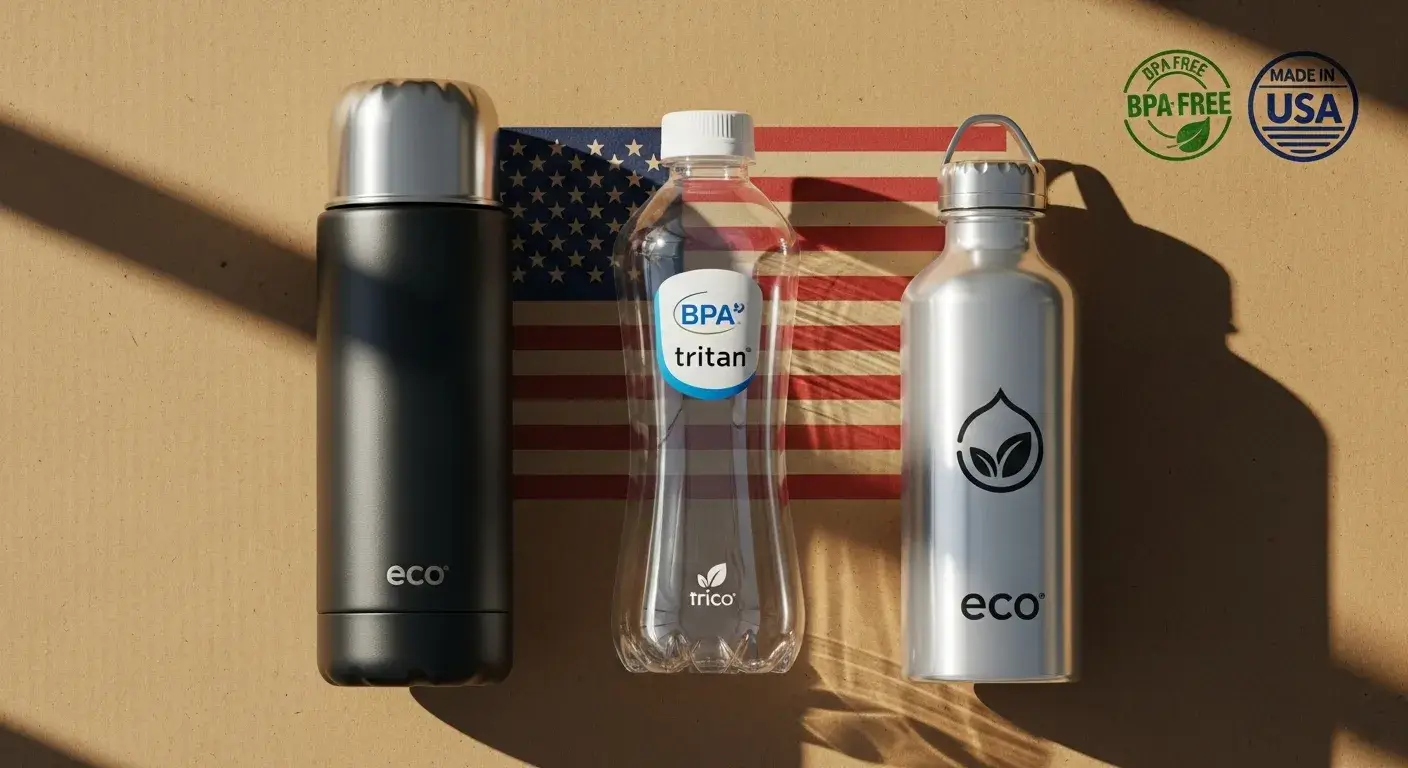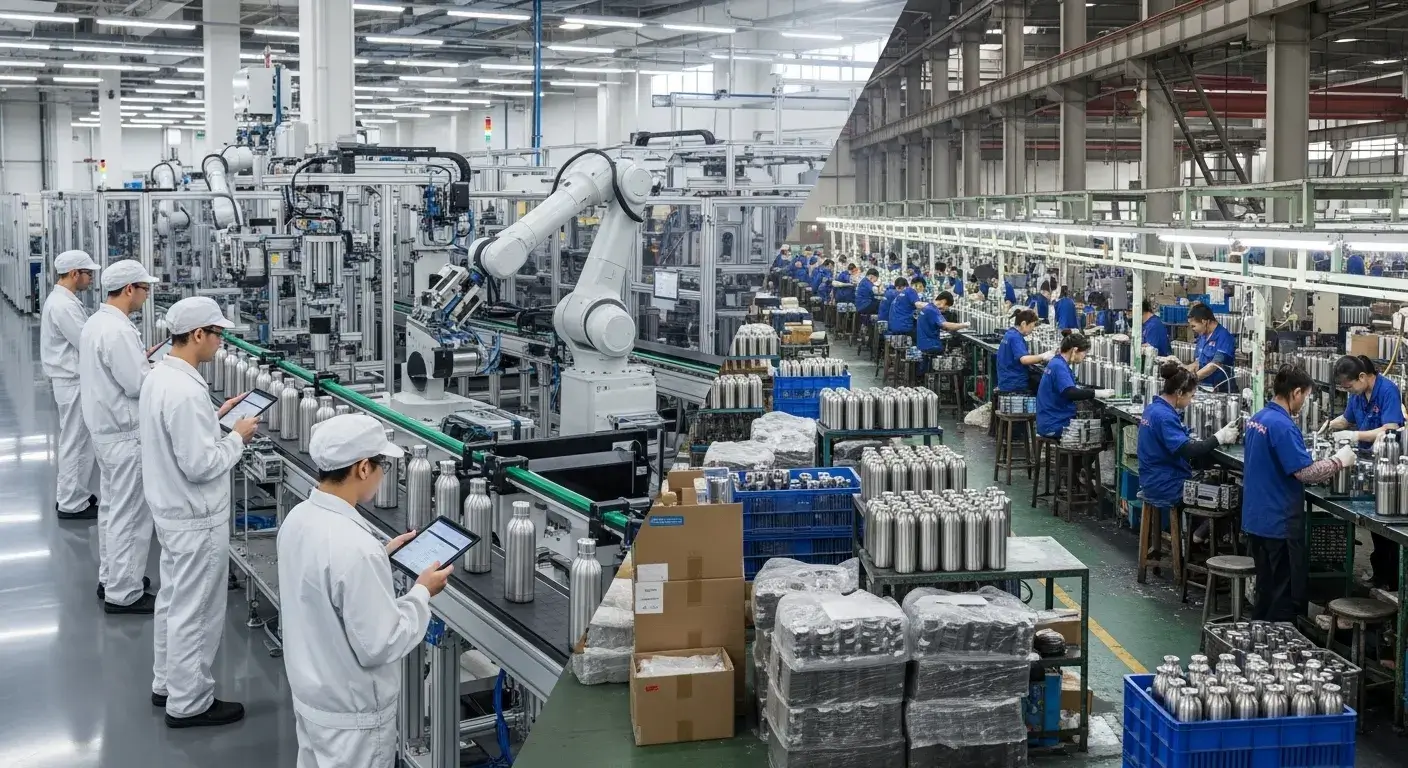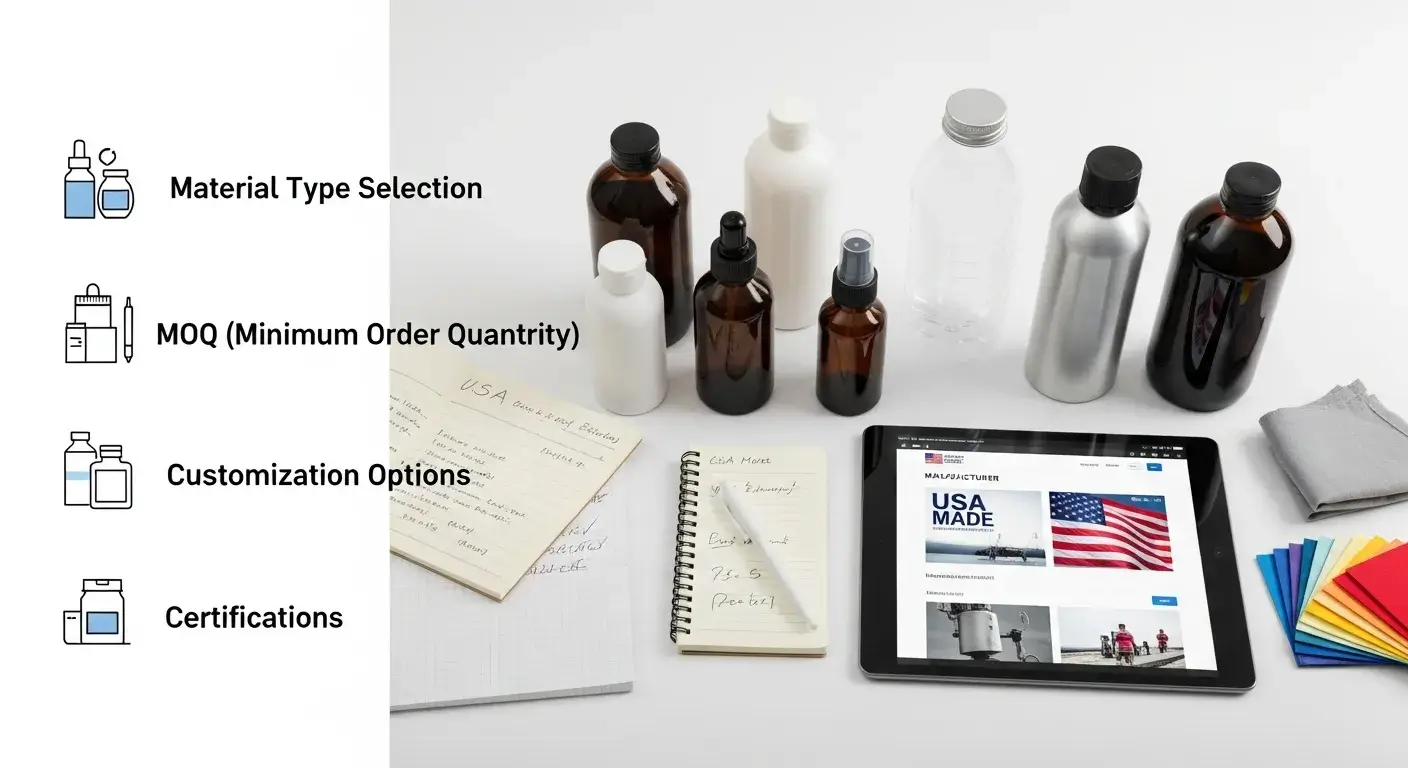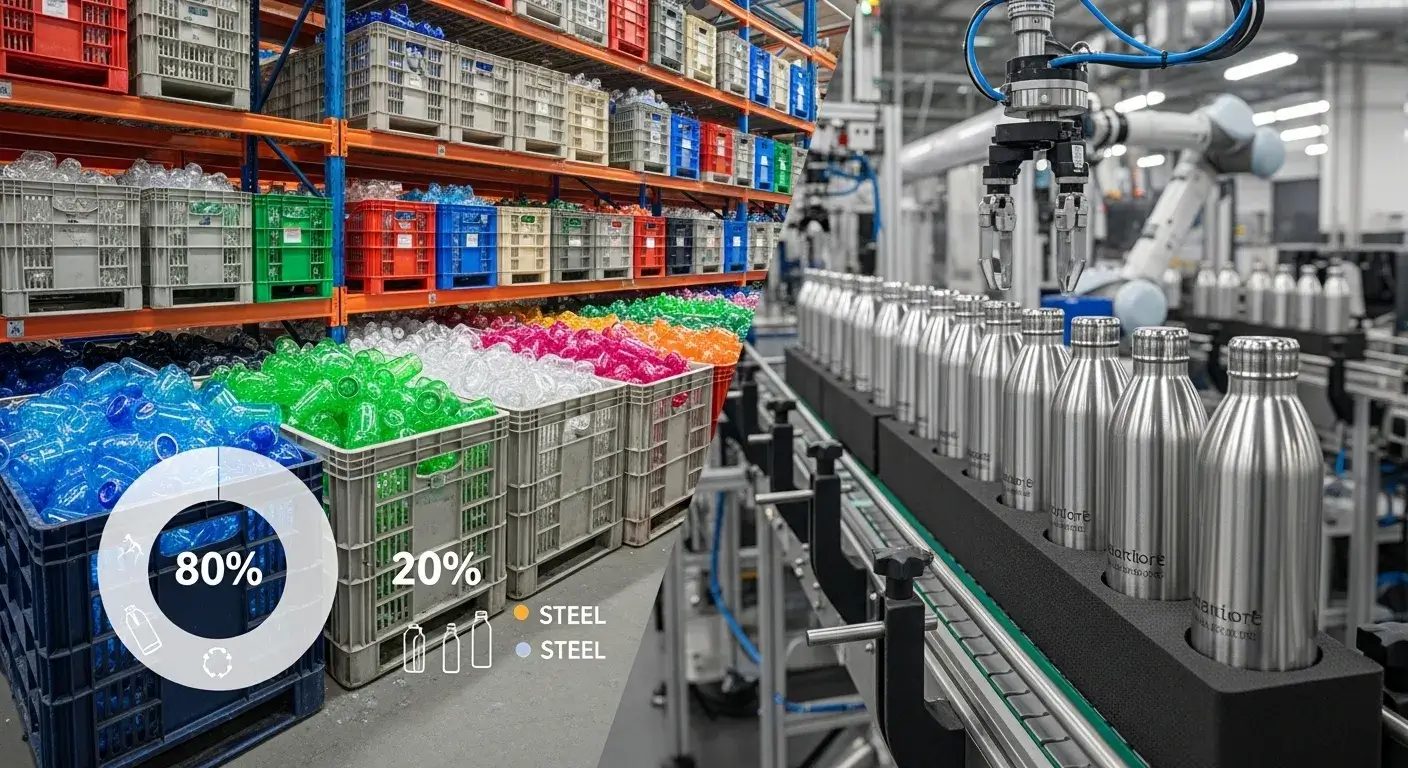
Tired of delays, quality issues, and greenwashing from imported water bottles? U.S. manufacturers may offer a smarter solution.
USA water bottle manufacturers offer local production, faster lead times, and reliable safety standards—making them a compelling option for ethical sourcing in 2025.
Here's how they compare to overseas suppliers, and why this shift could future-proof your sourcing strategy.
What Sets USA Water Bottle Manufacturers Apart from Overseas Competitors?
You're weighing costs, timelines, and trust—so what makes "Made in USA" worth it?
U.S. water bottle manufacturers prioritize safety, labor ethics, and shorter lead times, with consistent quality and fewer sourcing risks than overseas competitors.

Key Differences in 2025
| Factor | USA Manufacturers | Overseas (China, India, Vietnam) |
|---|---|---|
| Lead Time | 2–4 weeks | 8–12+ weeks |
| Certifications | FTC-regulated "Made in USA"1, FDA compliant2 | Varies by factory, often unverified |
| Material Traceability | High (e.g., Nalgene, Klean Kanteen) | Limited transparency |
| Labor Practices | Regulated and ethical | Inconsistent; dependent on audits |
| Sustainability Claims | Verified (B Corp, recycled materials) | Often overstated without lifecycle data |
| Tariff Exposure | None for domestic | Up to 25% in 2025 due to trade tensions |
Quote:
"I switched to a U.S. partner for my private label brand—my lead times were cut in half and quality issues vanished." – Small business owner, Illinois
How Do You Choose the Right USA Water Bottle Manufacturer for Custom Needs?
Not all "Made in USA" manufacturers are equal. Picking the right one can make or break your product launch.
Look for domestic manufacturers with proven experience in your material type, low MOQs, strong customization capabilities, and clear compliance history.

Key Selection Criteria
-
Material Focus:
- Plastic (Tritan/PET): Nalgene, Amcor, Bulletin Bottle
- Stainless Steel: Tru Flask (assembly in USA), Liberty Bottleworks (WA-based)
-
Minimum Order Quantity (MOQ):
- Ranges from 100 (50 Strong) to 1,000+ units depending on customization level.
-
Custom Features to Check:
- Logo printing (pad/screen/laser)
- Lid style variations
- Color customization
- BPA-free certification
-
Where to Find Them:
- ThomasNet
- CustomEarthPromos
- Trade show directories (e.g., ASD Market Week USA)
Tip: Ask for proof of domestic production—true U.S. manufacturing includes molding, assembly, and decoration on U.S. soil.
Are USA-Made Water Bottles Truly Sustainable and BPA-Free as Claimed?
You've seen the claims—but how do they hold up?
Yes—most U.S.-made bottles use BPA-free3 materials and many adopt recycled plastics or steel. Sustainability is increasingly supported with real certifications like B Corp4 or Cradle to Cradle.

Material + Eco Claims Breakdown
| Brand | BPA-Free | Recycled Material Use | Certifications |
|---|---|---|---|
| Nalgene | ✅ | Up to 50% rPET | FDA compliant |
| Klean Kanteen | ✅ | 90% recycled steel | B Corp, Climate Neutral Certified5 |
| Liberty Bottleworks | ✅ | Local recycled aluminum | Zero Waste Certified |
| 50 Strong | ✅ | In-house recycled plastic | Made in USA verified |
Note: Some brands use imported stainless but handle final assembly in the U.S. This impacts the "Made in USA" claim—check for FTC compliance.
What's the Current Landscape of Stainless Steel vs. Plastic Production in the USA?
Most people don't realize this—plastic still rules U.S. bottle production.
In 2025, plastic bottles make up roughly 80% of U.S. water bottle production, while stainless steel is still limited due to raw material sourcing and manufacturing complexity.

Market Overview
-
Plastic Bottles:
- High availability
- More custom molding capacity (e.g., Amcor, Bulletin)
- Common for sports, schools, events
-
Stainless Steel Bottles:
- Limited U.S. capacity—most steel imported
- Assembled in USA (e.g., Takeya, Liberty)
- Premium positioning with higher prices
2025 Trend Watch:
Recycled PET (rPET)6 is up 25% YoY, driven by corporate ESG targets7. Expect more brands to offer eco-certified plastic options.
How Can Partnering with USA Manufacturers Boost Your Supply Chain Resilience?
Supply chain issues aren't going away—smart brands are turning local for reliability.
Partnering with USA-based manufacturers reduces delays, avoids tariffs8, improves inventory turns, and supports domestic economic growth.

Resilience Benefits
- Shorter Lead Times: 2–4 weeks vs. 2–3 months overseas
- Tariff-Free Imports: No duties, especially on steel or plastic parts
- Easier Quality Control: Domestic site visits, faster sample cycles
- Brand Advantage: "Made in USA" can boost perceived value up to 25%
"After COVID and port delays, we brought our water bottle sourcing back to the U.S. It gave us speed, consistency, and brand trust." – Eco brand founder, Oregon
Conclusion
USA-made water bottles offer safer materials, faster fulfillment, and a clear path to ethical, sustainable sourcing in 2025—an investment that pays off long-term.
FAQs
Q: Who are the top water bottle manufacturers in the USA?
A: Nalgene (plastic), Takeya USA (stainless), Klean Kanteen (recycled steel), Bulletin Bottle (custom Tritan), Liberty Bottleworks (eco aluminum).
Q: Are there stainless steel bottles fully made in the USA?
A: Very few. Most are assembled in the U.S. using imported steel. Liberty and Tru Flask come closest.
Q: What's the MOQ for custom USA water bottles?
A: Typically 100–1,000 units depending on brand and customization. 50 Strong and Bulletin offer lower MOQs.
Q: Are USA-made bottles really safer than imports?
A: Yes. They meet strict FDA and FTC guidelines, with consistent BPA-free and food-safe compliance.
Q: How much more do USA-made bottles cost?
A: Expect 20–50% higher prices—but fewer defects, faster delivery, and marketing upside often outweigh the difference.
Footnotes
-
The Federal Trade Commission's "Made in USA" standard requires that products advertised as such must be "all or virtually all" made in the United States, meaning final assembly, processing, and all significant processing must occur domestically with no or negligible foreign content. ↩
-
The FDA regulates food contact substances including water bottle materials through comprehensive safety standards, requiring manufacturers to demonstrate that materials are safe for their intended use and do not transfer harmful substances to food or beverages. ↩
-
BPA-free means products contain no Bisphenol A, a chemical once common in plastics that can leach into food and beverages. The FDA has expressed concerns about BPA's effects on health, leading manufacturers to adopt safer alternatives like Tritan copolyester for food contact applications. ↩
-
B Corporation certification from B Lab requires companies to meet verified social and environmental performance standards, legal accountability requirements, and public transparency by scoring 80+ points on their impact assessment across governance, workers, community, and environmental categories. ↩
-
Climate Neutral Certified brands must measure their complete carbon footprint, purchase verified carbon credits to offset 100% of emissions, and implement reduction plans—providing transparent, third-party verified climate action beyond mere claims. ↩
-
Recycled PET (rPET) is post-consumer plastic that has been collected, cleaned, and reprocessed into new bottle-grade material, reducing virgin plastic demand by up to 75% and significantly lowering the carbon footprint of plastic bottle production. ↩
-
Corporate ESG (Environmental, Social, and Governance) targets are measurable sustainability goals that companies set to reduce environmental impact, improve social responsibility, and strengthen governance practices—driving procurement decisions toward sustainable suppliers and materials. ↩
-
Tariffs are taxes imposed on imported goods by the U.S. government, with rates varying by product category and country of origin. Current water bottle tariffs can reach 25% depending on material and source country, significantly impacting total landed costs. ↩

